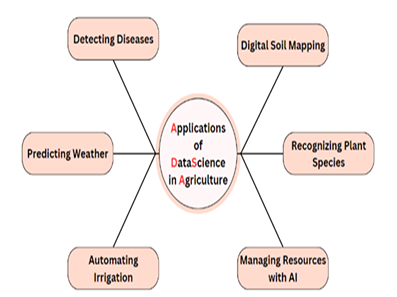Towards a Greener Tomorrow: The Role of Data Science in Shaping Sustainable Farming Practices
Main Article Content
Abstract
- Sustainable farming practices are essential for addressing global food security challenges while minimizing environmental impact. However, traditional agricultural methods face numerous obstacles, including impacts of climate change, resource scarcity, and population growth, creating a necessity to incorporate innovative approaches to ensure long-term sustainability. This review aims to comprehensively explore the integration of data science within the agricultural domain to enhance sustainability. By examining the role of data science in addressing agricultural challenges, the review aims to illuminate how data-driven approaches can revolutionize farming practices. The review adopts a systematic approach to analyze the existing literature on data science applications in agriculture. Criteria for selecting relevant studies include their focus on data science techniques and their applicability to agricultural contexts. Data science techniques have made significant contributions to sustainable agricultural practices. Key findings reveal that the collaborative efforts among Data Scientists, Agronomists, IT and Software Engineers, and Decision-Makers are crucial in addressing challenges such as data privacy, security, and scalability. Various algorithmic approaches, such as predictive analytics and machine learning models, are showcased for crop and soil management, irrigation systems, and supply chain optimization. Data science has vast practical implications for farming. It can improve efficiency, productivity, and environmental impact, paving the way for a more sustainable and resilient agricultural future.
Article Details

This work is licensed under a Creative Commons Attribution-NonCommercial 4.0 International License.
IJCERT Policy:
The published work presented in this paper is licensed under the Creative Commons Attribution 4.0 International (CC BY 4.0) license. This means that the content of this paper can be shared, copied, and redistributed in any medium or format, as long as the original author is properly attributed. Additionally, any derivative works based on this paper must also be licensed under the same terms. This licensing agreement allows for broad dissemination and use of the work while maintaining the author's rights and recognition.
By submitting this paper to IJCERT, the author(s) agree to these licensing terms and confirm that the work is original and does not infringe on any third-party copyright or intellectual property rights.
References
Bronson, K., & Knezevic, I. (2016). Big Data in food and agriculture. Big Data & Society, 3(1), 2053951716648174.DOI:10.1177/2053951716648174
Wolfert, S., Ge, L., Verdouw, C., & Bogaardt, M. J. (2017). Big data in smart farming–a review. Agricultural systems, 153, 69-80. DOI:10.1016/j.agsy.2017.01.023
Kumar, S. P., Subeesh, A., Jyoti, B., & Mehta, C. R. (2023). Applications of Drones in Smart Agriculture. In Smart Agriculture for Developing Nations: Status, Perspectives and Challenges (pp. 33-48). Singapore: Springer Nature Singapore. DOI: https://doi.org/10.1007/978-981-19-8738-0_3
Kamilaris, A., Gao, F., Prenafeta-Boldu, F. X., & Ali, M. I. (2016, December). Agri-IoT: A semantic framework for Internet of Things-enabled smart farming applications. In 2016 IEEE 3rd World Forum on Internet of Things (WF-IoT) (pp. 442-447). IEEE. DOI: 10.1109/WF-IoT.2016.7845467
(12)Nehrey, M., Koval, T., Rogoza, N., & Galaieva, L. (2022, August). Application possibilities of data science tools in agriculture: A review. In International Conference of Artificial Intelligence, Medical Engineering, Education (pp. 253-263). Cham: Springer Nature Switzerland. DOI:10.1007/978-3-031-24468-1_23
Cravero, A., & Sepúlveda, S. (2021). Use and adaptations of machine learning in big data—Applications in real cases in agriculture. Electronics, 10(5), 552. https://doi.org/10.3390/electronics10050552
Akhter, R., & Sofi, S. A. (2022). Precision agriculture using IoT data analytics and machine learning. Journal of King Saud University-Computer and Information Sciences, 34(8), 5602-5618. https://doi.org/10.1016/j.jksuci.2021.05.013
Chen, J., He, S., & Li, X. (2021). A study of big data application in agriculture. In Journal of Physics: Conference Series (Vol. 1757, No. 1, p. 012107). IOP Publishing. doi:10.1088/1742-6596/1757/1/012107.
Sidhu, K. S., Singh, R., Singh, S., & Singh, G. (2021). Data science and analytics in agricultural development. Environment Conservation Journal, 22(SE), 9-19. DOI:10.36953/ECJ.2021.SE.2202
Kuchkorov, T., Atadjanova, N., & Sayfullaeva, N. (2019, November). Big data analysis for soil monitoring in Smart farming. In 2019 International Conference on Information Science and Communications Technologies (ICISCT) (pp. 1-4). IEEE. DOI:10.1109/ICISCT47635.2019.9012016
Lokhorst, C., De Mol, R. M., & Kamphuis, C. (2019). Invited review: Big Data in precision dairy farming. Animal, 13(7), 1519-1528. DOI: 10.1017/S1751731118003439
Kamilaris, A., Kartakoullis, A., & Prenafeta-Boldú, F. X. (2017). A review on the practice of big data analysis in agriculture. Computers and electronics in agriculture, 143, 23-37. DOI:10.1016/j.compag.2017.09.037
Ribeiro, M. T., Singh, S., & Guestrin, C. (2016, August). " Why should i trust you?" Explaining the predictions of any classifier. In Proceedings of the 22nd ACM SIGKDD international conference on knowledge discovery and data mining (pp. 1135-1144).https://doi.org/10.48550/arXiv.1602.04938.





